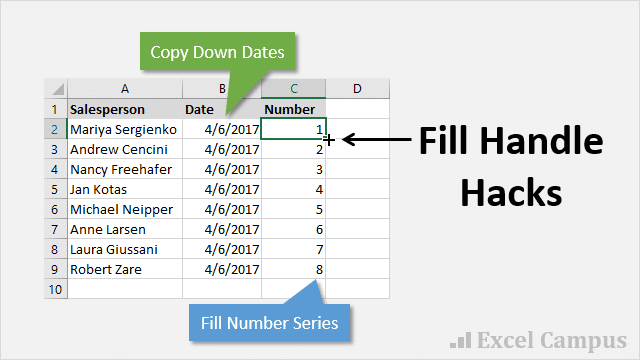

$Path = “$env:temp$(Get-Date -Format yyyyMMddHHmmss)report.csv” Here’s sample script that illustrates how easily that can be done: To make array content display correctly in Excel, arrays need to be converted to strings. When you look at the data, the columns Data and ReplacementStrings contain unreadable stuff. The next piece of script outputs the 10 newest error events from your System event log to Excel.
#Excel for mac 2008 fill handle windows#
Because typically, when Windows PowerShell exports arrays of information, they do not display well in Excel. They are just fine-which might surprise you. Look at the columns RequiredServices and DependentServices. Take a look at the Excel spreadsheet that uses color again. Select-Object -ExpandProperty Path -First 1 Turning arrays into string Resolve-Path -Path ‘C:Program Files*Microsoft OfficeOffice*EXCEL.EXE’ | If you wanted to know that path, too, then simply ask Resolve-Path: By replacing version numbers in the path, Windows PowerShell can launch any Excel version that happens to be installed. Start-Process accepts a file path that can contain wildcard characters. Note how Windows PowerShell automatically identifies the Excel version you use. To create a Excel spreadsheet with color, the HTML file needs to be fed directly into excel.exe. The trick is to create an HTML report that gives you all the formatting opportunities you need. Start-Process -FilePath ‘C:Program Files*Microsoft OfficeOffice*EXCEL.EXE’ -ArgumentList $Path # get all services and create custom HTML report:įorEach-Object -Begin $begin -Process $process -End $end | Get-Process | Where-Object ’ -f $style, $_.DisplayName, $_.Status, ($_.RequiredServices -join ‘,’), ($_.DependentServices -join ‘,’)

It’s trivial to use: simply pipe anything to Out-GridView, and it will happily display the content in a mini-spreadsheet: Out-GridView: Built-in “mini-Excel”īefore I touch Excel, let’s first look at its little cousin, which ships with Windows PowerShell: Out-GridView. Let’s take a look at how Windows PowerShell can output data to Excel fast, safe, and reliably. However, the scripting tactics have changed from the good old VBScript times. Microsoft Excel is a great tool to share Windows PowerShell data. Let’s welcome back guest blogger, Tobias Weltner…
:max_bytes(150000):strip_icc()/CustomLists-5bd88b44c9e77c005119348b.jpg)
Microsoft Scripting Guy, Ed Wilson, is here. After autofilling, you can change the cells independently of each other.Summary: Microsoft PowerShell MVP, Tobias Weltner, talks about Windows PowerShell and Excel interaction. For example, if two selected cells contain 1 and 4, the values 7 and 10 are added when you drag over the adjacent two cells (values are incremented by 3).Īutofilling doesn’t establish an ongoing relationship among cells in the group. You can also autofill cells using a pattern of values. Select these cells, move the pointer over a border of the selection until a yellow autofill handle (a dot) appears, then drag the handle over the cells you want to fill.
#Excel for mac 2008 fill handle series#
Autofilling overwrites existing data with the content you’re adding.Īutofill cells with sequential content or patterns from adjacent cells: Type the first two items of the series in the first two body cells (not header or footer cells) of the row or column you want to fill for example, type A and B.
:max_bytes(150000):strip_icc()/fill-down-excel-fill-handle-56a8f7aa5f9b58b7d0f6c7b4.gif)
Drag the handle over the cells where you want to add the content.Īny data, cell format, formula, or fill associated with the selected cells is added, but comments aren’t. You can quickly fill cells, or a row or column, with the same formula, data, or a logical sequence of data-for example, a series of numbers, letters, or dates.Īutofill one or more cells with content from adjacent cells: Select the cells with the content you want to copy, then move the pointer over a border of the selection until a yellow autofill handle appears.


 0 kommentar(er)
0 kommentar(er)
